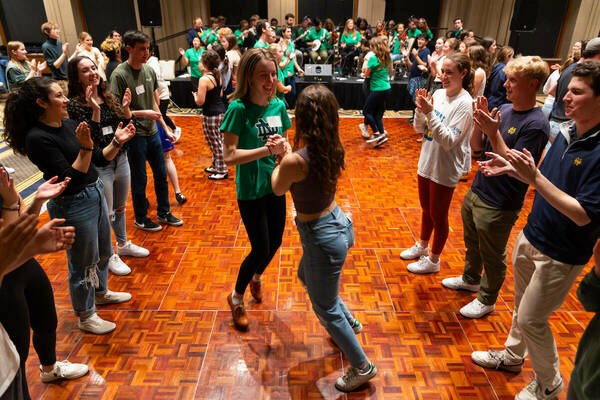
The Society for Disability Studies recently presented its Tyler Rigg Award to Essaka Joshua, a teaching professor in Notre Dame’s Department of English and the Joseph Morahan Director of the College Seminar program in the University’s College of Arts and Letters.
Joshua received the accolade—given annually to the best paper in literature and literary analysis published in Disability Studies Quarterly—for “The Drifting Language of Architectural Accessibility in Victor Hugo’s Notre-Dame de Paris.”
It is included in a volume John Duffy, associate professor of English and the Francis O’Malley Director of the University Writing Program at Notre Dame, edited with Melanie Yergeau of the University of Michigan.
Judges called the piece “a smart, fresh, and incisive look at how architecture and disability overlap and inform each other.”
Joshua, who founded Notre Dame’s Disability Studies Forum in 2008, says she was “genuinely thrilled and honored” by the award. “The Society for Disability Studies is the major society for scholars working in the field, and it’s great to be recognized nationally.”
Challenging Assumptions
“Disability studies is an interdisciplinary field within the humanities and social sciences that understands disability to be something more than a medical condition,” Joshua says. “It’s dedicated to recovering a more nuanced history that does justice to the diversity of this important group and its push towards equal rights.”
Joshua’s own journey to disability studies was inspired by reading an essay by Lennard Davis in the Norton Anthology of Theory and Criticism when she was teaching an introduction to literature and critical theory course at Birmingham University in the United Kingdom.
“It outlined the range of prejudicial assumptions that we make about normalcy,” Joshua says. “My students loved it, and I quickly found myself rereading everything differently. On the personal side, as a black woman, I’ve been familiar with prejudice and exclusion all of my life, so it was a natural topic for me, as disability is part of a wider set of social justice issues.”
Teaching is also how she came to her award-winning topic, says Joshua, who offers a College Seminar called Disability. A signature course for all sophomores in the College of Arts and Letters, College Seminar covers a variety of topics each semester. Students explore enduring issues that transcend disciplinary boundaries while honing their analytic and verbal communication skills.
“Aside from Frankenstein, which is also in my Disability seminar, Notre-Dame de Paris is probably the most famous novel about a person with a disability,” Joshua says. “It was an obvious choice for me. It has Catholic subject matter, it’s a classic novel, and this generation of students is very familiar with the Disney film (The Hunchback of Notre Dame).
“It’s probably the novel with the greatest number of characters with disabilities, too,” she says, “so it’s particularly rewarding to teach.”
Embracing Complexity
In her award-winning article, Joshua explores the ways in which Hugo uses the disabled body as a symbol for the cathedral building.
“Quasimodo is Notre Dame because they are both complex, atypical bodies,” she says. “At times, Hugo characterizes the building as a body with multiple disabilities, and at times he describes it as part of Quasimodo’s body. It is his carapace, and he is its contents.”
Unlike the wheelchair user confronted with the staircase, Joshua says, Hugo’s Quasimodo is harmoniously included as the cathedral’s natural contents. “We talk today of the importance of ‘universal design’—designs of buildings or objects that include people with disabilities. Long before this concept, we have Hugo using an inclusive architectural language of disability.”
The novel also was groundbreaking for its portrayal of someone with a disability, she says. “It begins with expressing deep-seated fears that have been traditionally associated with disability, characterizing Quasimodo as evil and frightening. But when Quasimodo breaks free of his subjection and shows compassion and goodness towards Esmeralda, he is transfigured and described as beautiful. It’s a story about breaking free from being brutalized.
“I think that it’s also a story that is as timeless as Beauty and the Beast. It says that inner beauty should be valued more highly than an assumed notion of physical beauty. Both tale types live on in multiple ways today.”


